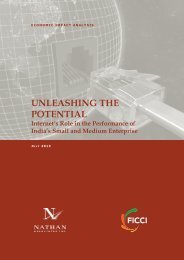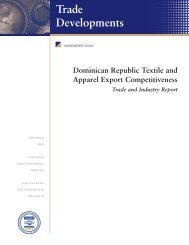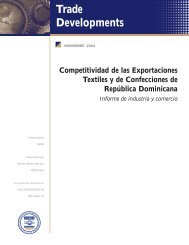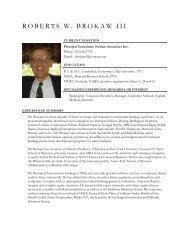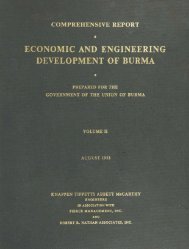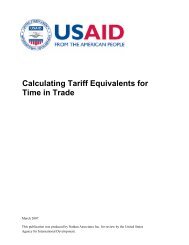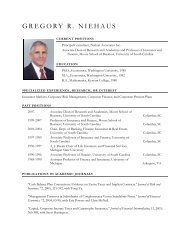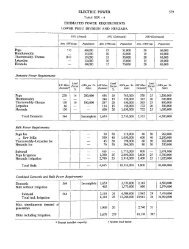Putting it to Work in Developing Countries - Nathan Associates
Putting it to Work in Developing Countries - Nathan Associates
Putting it to Work in Developing Countries - Nathan Associates
You also want an ePaper? Increase the reach of your titles
YUMPU automatically turns print PDFs into web optimized ePapers that Google loves.
17 World Bank, Global Economic Prospects 2003, pp.<br />
46–49. The real annual rate of growth <strong>in</strong> develop<strong>in</strong>g<br />
county FDI <strong>in</strong>flows for 1978–2001 is calculated us<strong>in</strong>g<br />
UNCTAD FDI data, deflated by the U.S. GDP defla<strong>to</strong>r.<br />
18 For discussion of <strong>in</strong>teraction between FDI and trade,<br />
and the role of mult<strong>in</strong>ationals <strong>in</strong> export growth and<br />
compet<strong>it</strong>iveness, see WIR 1999, pp.229–256; and WIR<br />
2002, pp. 151–161. See also UNCTAD’s conclusions<br />
<strong>in</strong> WTO Document WT/WGTI/W/8/Add.1,<br />
“Implications of the Relationship between Trade and<br />
Investment for Development and Economic Growth,”<br />
pp. 14–16.<br />
19 For a summary of research and analysis of productiv<strong>it</strong>y-<strong>in</strong>duc<strong>in</strong>g<br />
effects of FDI, see Theodore H. Moran,<br />
Harness<strong>in</strong>g Foreign Direct Investment for Development<br />
Policies for Developed and Develop<strong>in</strong>g <strong>Countries</strong>,<br />
Wash<strong>in</strong>g<strong>to</strong>n DC: Center for Global Development<br />
(2006), pp. 6-27; Theodore H. Moran, Parental<br />
Supervision: the New Paradigm for Foreign Direct<br />
Investment, Wash<strong>in</strong>g<strong>to</strong>n DC: Inst<strong>it</strong>ute for International<br />
Economics (2001); and Theodore H. Moran, “How<br />
Does FDI Affect Host Country Development Us<strong>in</strong>g<br />
Industry Case Studies <strong>to</strong> Make Reliable<br />
Generalizations,” <strong>in</strong> Does Foreign Direct Investment<br />
Promote Development<br />
20 Many studies demonstrate significant productiv<strong>it</strong>y<br />
improvements among firms receiv<strong>in</strong>g FDI. See Jens<br />
Arnold and Beata Javorcik, “Gifted Kids or Pushy<br />
Parents Foreign Acquis<strong>it</strong>ions and Plant Performance <strong>in</strong><br />
Indonesia,” World Bank Policy Research <strong>Work</strong><strong>in</strong>g<br />
Paper 3597 (May 2005); and Simeon Djankov and<br />
Bernard Hoekman, “Foreign Investment and<br />
Productiv<strong>it</strong>y Growth <strong>in</strong> Czech Enterprises,” <strong>in</strong> Global<br />
Integration & Technology Transfer, ed., Bernard<br />
Hoekman and Beata Smarzynska Javorcik, Wash<strong>in</strong>g<strong>to</strong>n<br />
DC: World Bank (2006).<br />
21 See for example, Beata Smarzynska Javorcik, “Does<br />
Foreign Direct Investment Increase the Productiv<strong>it</strong>y of<br />
Domestic Firm In Search of Spillovers through<br />
Backward L<strong>in</strong>kages,” World Bank Policy Research<br />
Paper 2923 (Oc<strong>to</strong>ber 2002). Javorcik demonstrates<br />
pos<strong>it</strong>ive vertical technology transfers from FDIf<strong>in</strong>anced<br />
foreign affiliates <strong>to</strong> upstream suppliers <strong>in</strong><br />
L<strong>it</strong>huania, especially among foreign-local jo<strong>in</strong>t ventures<br />
(but not so w<strong>it</strong>h wholly owned foreign affiliates). The<br />
study also f<strong>in</strong>ds an absence of technology transfer<br />
between FDI-f<strong>in</strong>anced foreign affiliates supply<strong>in</strong>g<br />
downstream local cus<strong>to</strong>mers. Further evidence of vertical<br />
spillovers for Czech and Latvian firms supply<strong>in</strong>g<br />
foreign affiliates is presented <strong>in</strong> Beata Smarzynska<br />
Javorcik and Mariana Spatareanu, “Disentangl<strong>in</strong>g FDI<br />
Spillover Effects: What Do Firm Perceptions Tell Us”<br />
<strong>in</strong> Moran et al., Does Foreign Direct Investment Promote<br />
Development In the same volume, <strong>in</strong> “Foreign Direct<br />
Investment and External<strong>it</strong>ies: the Case for Public<br />
Intervention,” Garrick Blalock and Paul Gertler show<br />
strong vertical spillovers <strong>to</strong> upstream suppliers of FDIf<strong>in</strong>anced<br />
foreign affiliates <strong>in</strong> Indonesia, and clear evidence<br />
of higher prof<strong>it</strong>abil<strong>it</strong>y, lower prices, <strong>in</strong>creased<br />
entry and <strong>in</strong>creased output <strong>in</strong> these supplier markets.<br />
22 Some studies show that technology transfer can take<br />
the form of vertical spillovers <strong>to</strong> suppliers and horizontal<br />
spillovers <strong>to</strong> domestic companies <strong>in</strong> the <strong>in</strong>dustry.<br />
See Liesbeth Dries and Johan F. M. Sw<strong>in</strong>nen, “Foreign<br />
Direct Investment, Vertical Integration, and Local<br />
Suppliers: Evidence from the Polish Dairy Sec<strong>to</strong>r,” <strong>in</strong><br />
World Development, Volume 32, No. 9 (May 2004). In<br />
analyz<strong>in</strong>g Indonesian manufactur<strong>in</strong>g, Robert Lipsey<br />
and Frederik Sjöholm demonstrate that horizontal productiv<strong>it</strong>y<br />
spillovers occur so long as compet<strong>it</strong>ion and<br />
absorptive capac<strong>it</strong>y are sufficient, and the technological<br />
gap among firms is not extreme (see “The Impact of<br />
Inward FDI on Host <strong>Countries</strong>, Why Such Different<br />
Answers” <strong>in</strong> Moran et al.). Alternatively, Brian J.<br />
A<strong>it</strong>ken and Ann E. Harrison, “Do Domestic Firms<br />
Benef<strong>it</strong> from Direct Foreign Investment: Evidence from<br />
Venezuela” <strong>in</strong> American Economic Review Vol. 89, No.<br />
3, conclude that while FDI boosts productiv<strong>it</strong>y <strong>in</strong> (relatively<br />
smaller) own-plant or jo<strong>in</strong>t venture operations,<br />
domestic firms suffer negative horizontal spillovers—<br />
loss of market share —<strong>in</strong> the presence of FDI <strong>in</strong> the<br />
same <strong>in</strong>dustry. Studies c<strong>it</strong>ed <strong>in</strong> notes 20 and 21 by<br />
Djankov and Hoekman <strong>in</strong> the Czech Republic,<br />
Javorcik and Spatareanu <strong>in</strong> the Czech Republic and<br />
Latvia, and Javorcik <strong>in</strong> L<strong>it</strong>huania, all fail <strong>to</strong> f<strong>in</strong>d evidence<br />
of horizontal spillovers.<br />
23 Vertical spillovers, for example, may operate more<br />
powerfully w<strong>it</strong>h partially foreign owned affiliates than<br />
w<strong>it</strong>h wholly owned ones, which may engage <strong>in</strong> more<br />
lim<strong>it</strong>ed local sourc<strong>in</strong>g. See Beata S. Javorcik and<br />
Mariana Spatareanu, “To Share or Not <strong>to</strong> Share: Does<br />
Local Participation Matter for Spillovers from Foreign<br />
Direct Investment” Rutgers Univers<strong>it</strong>y <strong>Work</strong><strong>in</strong>g Paper<br />
No 2006-001. Also, Susan Fe<strong>in</strong>berg and Michael P.<br />
Keane, “Intrafirm Trade of US MNCs: F<strong>in</strong>d<strong>in</strong>gs and<br />
Implications for Models and Policies Toward Trade and<br />
Investment,” <strong>in</strong> Moran et al., conclude that mult<strong>in</strong>ationals<br />
engaged <strong>in</strong> <strong>in</strong>trafirm trade seem more likely <strong>to</strong><br />
transfer best practices and knowledge than mult<strong>in</strong>ationals<br />
not so organized.<br />
24 In Asia, the ADB surveys technology and productiv<strong>it</strong>y<br />
spillovers and f<strong>in</strong>ds that they are pos<strong>it</strong>ive for the<br />
economy generally and for specific <strong>in</strong>dustries, but that<br />
the magn<strong>it</strong>ude of the impacts varies and the rate of<br />
transfer is slow. The ADB underscores the importance<br />
of a policy framework maximiz<strong>in</strong>g research and development<br />
and tra<strong>in</strong><strong>in</strong>g <strong>to</strong> leverage technology transfer<br />
opportun<strong>it</strong>ies of FDI. See ADB, Asian Development<br />
Outlook 2004, Part 3 Foreign Direct Investment <strong>in</strong><br />
Develop<strong>in</strong>g Asia, at pp. 226–230.<br />
94



